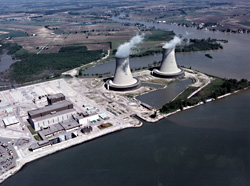Environmental coalition continues international resistance to Fermi 3
 NRC file photo of Fermi 2 on the Lake Erie shore, where Detroit Edison wants to build a giant new reactorOn Feb. 13, 2012, attorney Terry Lodge of Toledo, on behalf of an environmental coalition, filed a rebuttal to challenges by the U.S. Nuclear Regulatory Commission staff and Detroit Edison. The agency and utility were challenging contentions filed by the environmental coalition on Jan. 11, 2012 concerning NRC's Draft Environmental Impact Statement (DEIS) about the new Fermi 3 reactor, a proposed General Electric-Hitachi ESBWR (so-called "Economic Simplified Boiling Water Reactor"). The new contentions involve such issues as impacts on endangered and threatened plant and animal species, and their critical habitats, from the overall Fermi 3 proposal, as well as related sub-proposals, such as the contemplated transmission line corridor; radiological health impacts on the Monroe County community from Fermi 3, which has already suffered a half century of radiological and toxic chemical harm from the Fermi 1 and Fermi 2 reactors, as well as a number of giant coal burning power plants; and impacts on the Walpole Island First Nation, just 53 miles away across the U.S./Canadian border. Ontario, Canada is located a mere 8 miles across Lake Erie from the Fermi nuclear power plant.
NRC file photo of Fermi 2 on the Lake Erie shore, where Detroit Edison wants to build a giant new reactorOn Feb. 13, 2012, attorney Terry Lodge of Toledo, on behalf of an environmental coalition, filed a rebuttal to challenges by the U.S. Nuclear Regulatory Commission staff and Detroit Edison. The agency and utility were challenging contentions filed by the environmental coalition on Jan. 11, 2012 concerning NRC's Draft Environmental Impact Statement (DEIS) about the new Fermi 3 reactor, a proposed General Electric-Hitachi ESBWR (so-called "Economic Simplified Boiling Water Reactor"). The new contentions involve such issues as impacts on endangered and threatened plant and animal species, and their critical habitats, from the overall Fermi 3 proposal, as well as related sub-proposals, such as the contemplated transmission line corridor; radiological health impacts on the Monroe County community from Fermi 3, which has already suffered a half century of radiological and toxic chemical harm from the Fermi 1 and Fermi 2 reactors, as well as a number of giant coal burning power plants; and impacts on the Walpole Island First Nation, just 53 miles away across the U.S./Canadian border. Ontario, Canada is located a mere 8 miles across Lake Erie from the Fermi nuclear power plant.
Citizen Environment Alliance of Southwestern Ontario is a member of the environmental coalition opposing Fermi 3, which also includes Beyond Nuclear, Citizens for Alternatives to Chemical Contamination, Don't Waste Michigan, and the Sierra Club Michigan Chapter.
 admin
admin







